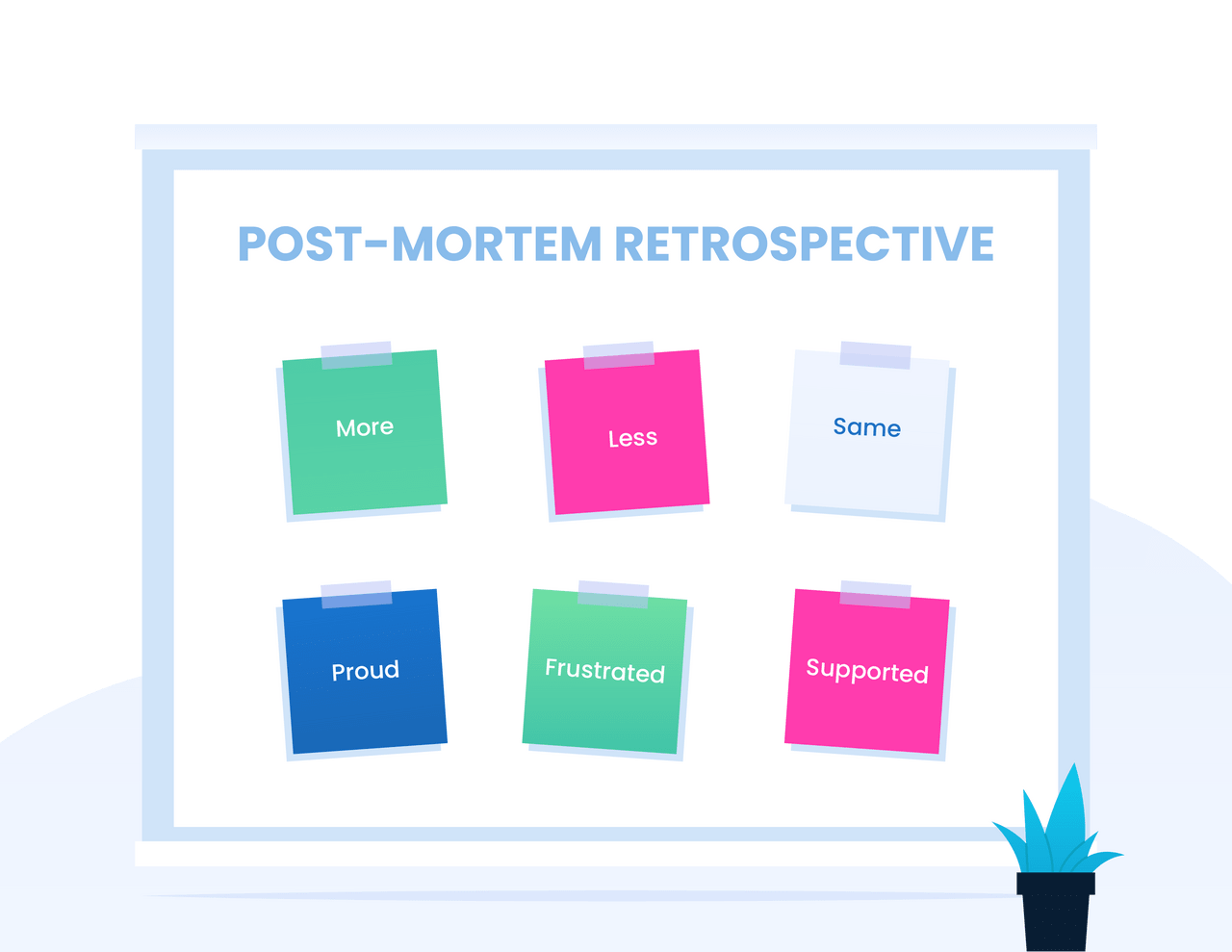The Project Post-Mortem Retrospective Template

It may sound like a cliche, but life is all about learning from our mistakes.
When it comes to product management and the agile methodology, that ethos is brought to life in the form of the post-project retrospective meeting, also known as a project post-mortem. And while it’s generally associated with software development, the post-mortem retrospective format is ideal for practically any group project.
With the free post-mortem template for EasyRetro, you’ll be able to review what went right, what went wrong, and — most importantly — how you could do things differently to secure better results going forward.
That’s the power of iteration in action. That’s the power of the retrospective.
What is a project post-mortem?
"If at first you don’t succeed, try, try, try again"
That’s the underpinning philosophy of the project post-mortem, and that one short sentence tells you much of what you need to know.
A project post-mortem is a meeting held by a team following the conclusion of a group project. All members of the team will gather to reflect on the entire project, be that a piece of software development or other task, and discuss what went well and what could have been done better.
You might have heard the term "sprint retrospective" in the context of software development, but the project post-mortem is a little different.
The difference between a sprint retrospective and post-mortem
The difference is simply that sprint retrospectives take place multiple times at a regular cadence throughout the course of a project. But the project post-mortem only takes place once.
The scope of a project post-mortem is a bit more all-encompassing too, covering the entire project roadmap from start to finish. A sprint retrospective, on the other hand, tends to deal exclusively with tasks completed during that small stretch of time (or sprint).
During a project post-mortem, members of the team will gather and discuss the following:
- Recap the project end-to-end, often comparing the initial plan to the end result.
- The objective aspects of the project — what went well or exceeded expectations.
- The flip-side of that: what didn’t quite go to plan (or failed spectacularly).
- Brainstorm solutions for how to improve the next project.
- The subjective feelings of team members (to assess less obvious impacts such as stress and burnout). Put simply, ask the question, Why did the project end this way?
- Appreciation for team members. This point is often neglected, but it can be a great way to build team morale going forward.
The benefits of a project post-mortem
Now that you’re familiar with a project post-mortem, let’s consider why your team might choose to host one at the conclusion of your next project.
Before we expand on that, though, it’s worth noting that project post-mortem retrospectives are incredibly easy to overlook (and therefore skip entirely).
Why do we mention this specifically?
Because, yes, everyone on the team might be feeling a little run down or burnt out. But the value a project post-mortems will bring far exceeds the minor inconvenience of sitting in a room for an hour. Furthermore, most team members will find that, once they start venting a little (in a controlled manner, of course), they’ll actually feel much better. It’s a cleansing process, too.
Now, about those benefits…
- Your product will always get better. The core benefit of the project post-mortem is that the product itself improves. No matter what you’re building, learning from past mistakes will make it better next time.
- You’ll be a closer, more tightly knit team. Being 100% open and honest about results and tactics can potentially raise some conflict. But the net gain will be one of bringing the team closer together. The positive effect might not be directly measurable, but you’ll see it in future results — we promise.
- Your team will feel more appreciated. It’s easy to fall into a culture of focusing only on what goes wrong. The project post-mortem lets you flip the script and show some appreciation for everyone you work with.
- You’ll foster a more constructive mindset. When teams feel like they have just one shot at something, they’ll be creatively stifled. The project post-mortem allows them the freedom to try new, more innovative solutions — even if they don't go to plan!

How to host a post-mortem meeting
Now that we’ve covered the what and the why of the post-mortem retrospective meeting, let’s move on to the how.
Let’s shift from the strategic to the tactical with a step-by-step of how to host a project post-mortem.
Step 1: Assemble your team (and make enough time)
You’d think that the first step would be the easiest. But for many businesses, actually getting the team to sit down for a post-mortem can be a tough task.
Be sure to set enough time for your project post-mortem, and to invite all stakeholders that contributed to the project — no matter how small. How much time you spend is up to you, but at least an hour is a good place to start.
Step 2: Set an agenda for the project post-mortem
Before you jump into the post-mortem, clearly lay out the agenda for the session. This will usually mean documenting the roadmap you went through, followed by the key outcomes at the end.
Step 3: Ask objective and subjective questions
We’ll dig into the specific questions to ask in the next section, but for now note that the questions you ask should cover the objective and the subjective. Objective stuff covers binary outcomes (“Did this get done or not?”) while subjective concerns are more about how team members feel.
Step 4: Discuss and brainstorm solutions
With the meeting agenda and key questions laid out, take the time to go through each point and discuss as a team. This is the heart of the project post-mortem, and it’s where all the actionable insights will make an appearance.
Ask one person to keep notes of everything. Check our free meeting minutes tool!
Step 5: Document key action items to be considered in your next kick-off
Once the discussion and brainstorming is done, you should have a list of clear and concise action items. This is essentially your playbook for the next project. It’ll help you replicate good results and divert away from bad ones. Over time, and over multiple projects, you’ll see your team — and your results — getting better and better.
5 questions to ask in your next post-mortem retrospective
By now you should be a veritable expert in the meaning behind the post-mortem meeting, the core rationale as to why you’d run them, and the nuts-and-bolts of how to actually get post-mortems running with your team.
Next up, we’ll take another step towards the tactical in an effort to make your next post-mortem retrospective run as smoothly as possible.
We’ve already mentioned the difference between the types of subjective and objective questions you might ask during the session, but there’s a lot to unpack there. So let’s do exactly that.
Before we jump in, remember that these are just suggestions. Every business is unique and every project plays by its own rules. Feel free to switch up and adapt these questions to best suit the way you work.
- Which part of the project are you most proud of? Asking this question will direct the conversation into a place of positivity, and give team members a chance to share appreciation.
- What was the most frustrating part of the process? In any project, there’s a moment when it all gets a bit too much. While frustrating at the time, this can provide valuable insight into how to do things better in the future.
- Did the leadership team and other stakeholders offer enough support? A feeling of isolation or lack of support can bring down even the most productive team. Asking how well leadership supported them can shed light on potential issues.
- What would you do differently if you could do it again? Framed as a neutral question, this one will allow team members to openly analyze specific pain points and open the door to constructive criticism. (Note the word constructive there).
- How well did we follow the initial project plan? Scope creep is almost inevitable in large-scale group projects, but it doesn’t have to happen every time. Assessing how far the team diverged — and why — can help alleviate the problem in the future.
Supercharge your next retrospective with a free post-mortem template
If you’re yet to discover the power of the retrospective meeting, our post-mortem meeting template is the quickest and easiest way to get started. Just download it, open it up in EasyRetro, and use it to guide your team through the process from start to finish.
We’ve covered a lot of the ins and outs of post-mortem meetings here, but — as with many things in life — the best way to learn is to give it a go for yourself.
Download the free post-mortem template for EasyRetro now and get your next project on the road to success.